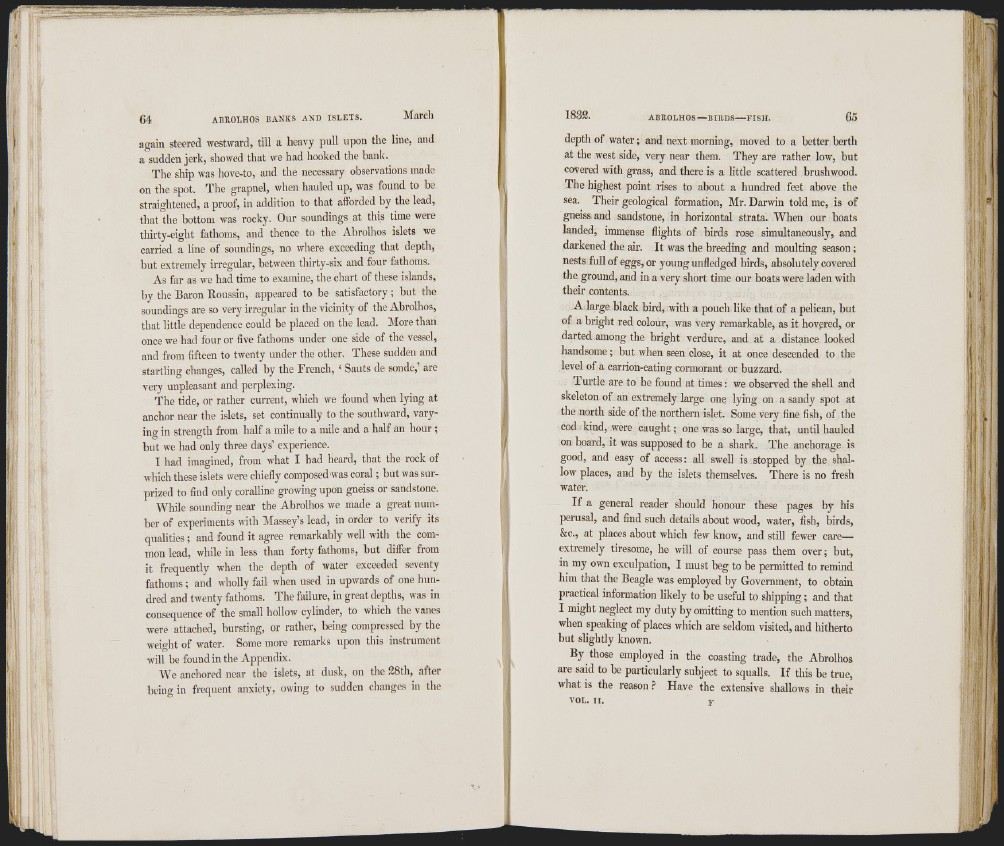
n' f-r
‘I ' I'i ■' , ii :::T: ::
64 ABROLHOS BANKS AND ISLETS. March
again steered westward, till a heavy pull upon the line, and
a sudden jerk, showed that we had hooked the bank.
The ship was hove-to, and the necessary observations made
on the spot. The grapnel, when hauled up, was found to be
straightened, a proof, in addition to that afforded by the lead,
that the bottom was rocky. Our soundings at this time were
thirty-eight fathoms, and thence to the Abrolhos islets we
carried a line of soundings, no where exceeding that depth,
but extremely irregular, between thirty-six and four fathoms.
As far as we had time to examine, the chart of these islands,
by the Baron Roussin, appeared to be satisfactory ; but the
soundings are so very irregular in the vicinity of the Abrolhos,
that little dependence could be placed on the lead. More than
once we had four or five fathoms under one side of the vessel,
and from fifteen to twenty under the other. These sudden and
startling changes, called by the French, ‘ Sants de sonde,’ are
very unpleasant and perplexing.
The tide, or rather current, which we found when lying at
anchor near the islets, set continually to the southward, varying
in strength from half a mile to a mile and a half an hour ;
hut we had only three days’ experience.
I had imagined, from what I had heard, that the rock of
which these islets were chiefly composed was coral; hut was surprized
to find only coralline growing upon gneiss or sandstone.
While sounding near the Abrolhos we made a great number
of experiments with Massey’s lead, in order to verify its
qualities ; and found it agree remarkably well with the common
lead, while in less than forty fathoms, hut differ from
it frequently when the depth of water exceeded seventy
fathoms; and wholly fail when used in upwards of one hundred
and twenty fathoms. The failure, in great depths, was in
consequence of the small hollow cylinder, to which the vanes
were attached, bursting, or rather, being compressed by the
weight of water. Some more remarks upon this instrument
will he found in the Appendix.
W^e anchored near the islets, at dusk, on the 28th, after
being in frequent anxiety, owing to sudden changes in tlie
Ir
1832. a b r o l h o s BIRDS FISH. 65
depth of water; and next morning, moved to a better berth
at the west side, very near them. They are rather low, but
covered with grass, and there is a little scattered brushwood.
The highest point rises to about a hundred feet above the
sea. Their geological formation, Mr. Darwin told me, is of
gneiss and sandstone, in horizontal strata. When our boats
landed, immense flights of birds rose simultaneously, and
darkened the air. I t was the breeding and moulting season ;
nests full of eggs, or young unfledged birds, absolutely covered
the ground, and in a very short time our boats were laden with
their contents.
A large black bird, with a pouch like that of a pelican, but
of a bright red colour, was very remarkable, as it hovpred, or
darted among the bright verdure, and at a distance looked
handsome; but when seen close, it at once descended to the
level of a carrion-eating cormorant or buzzard.
Turtle are to be found at times: we observed the shell and
skeleton of an extremely large one lying on a sandy spot at
the north side of the northern islet. Some very fine fish, of the
cod kind, were caught; one was so large, that, until hauled
on board, it was supposed to be a shark. The anchorage is
good, and easy of access: all swell is stopped by the shallow
places, and by the islets themselves. There is no fresh
water.
I f a general reader should honour these pages by his
perusal, and find such details about wood, water, fish, birds,
&c., at places about which few know, and still fewer care—
extremely tiresome, he will of course pass them over; but,
in my own exculpation, I must beg to be permitted to remind
him that the Beagle was emploj'ed by Government, to obtain
practical information likely to be useful to slfipping; and that
I might neglect my duty by omitting to mention such matters,
when speaking of places which are seldom visited, and hitherto
but slightly known.
By those employed in the coasting trade, the Abrolhos
are said to be particularly subject to squalls. I f this be true,
what is the reason ? Have the extensive shallows in their
VOL. I I . V
111